
Man does not become human,
but is always human.
Erich Blechschmidt
The fourth week: the form emerges
In the fourth week the embryo (the embryonic disc) will grow from about 2 to about 6 mm. The processes of the third week (neural tube formation, development of blood circulation) continue in the fourth week. At the same time, the amnion increases enormously in size, while the yolk sac does not. This is the cause of a great change in the form.
The growth of the amnion
In the third week, the embryonic disc got thickness and a symmetry-axis. The tissues of the embryonic disc extend into the tissues of the peripheral organs: ectoderm into the amnion membrane, entoderm into the wall of the yolk sac and mesoderm into the extra-embryonic mesoderm and the connective stalk. The embryo is still an open disc on all sides, with ectoderm on the backside and entoderm on the breastside.
In order to let an independent body come into being, a skin has be formed around the entire embryo. This happens by a dramatic growth of the amnion, that is pushed to the outside through the pressure of the amniotic fluid. The yolk sac is not growing and its liquid does not give pressure, which results in a yolk sac that hangs loose. By these growth-movements, the amnion enfolds around the embryonic disc. This happens all around: at the head, the tail and on both lateral sides. It happens faster at the head side than at the tail side.
In figures 28 to 31 this enfolding process is shown. It is difficult to imagine this three-dimensional process. It is advisable to compare the drawn sections, copy them and draw other cross-sections (eg. through the heart) in order to understand the process better.
What happens?
- With the growth of the amnion the relatively large heart is moved from its cranial position above the head to its destination in the chest (Fig. 28 to 30).
- A little later the connective stalk is pushed towards the belly, to a place somewhat caudal from the heart. The umbilical cord will eventually develop around it.
- The neural tube thickens quickly on the cranial end, causing the cranial end to fold inside.
- The amnion pushes the yolk sac to the inside on the cranial and caudal as well as the lateral sides. The solidity that the notochord gives to the embryonic disc causes the embryonic disc to stay more or less straight. Ectoderm and entoderm are joined together at the mouth membrane and at the cloacal membrane by hinging points. This leads to the formation of the digestive tract (Fig. 29, 30).
- The formation of the digestive tract goes from the tips to the centre.
- The umbilical cord is created in the centre. It attaches the embryo to the chorion and it transports nutrients and waste products.
- In the umbilical cord the connective stalk, the yolk sac and allantois are found (Fig. 31).
- In the enclosing of the embryonic disc by the amnion, a part of the chorion is included in the embryo as the body cavity (the intra-embryonic coelom; Fig. 29 and 30).
- The embryo becomes more or less cylindrical, and later it makes a wrapping movement in longitudinal direction (Fig. 31).
- Once it is formed, the digestive tract grows rapidly (Fig. 31).
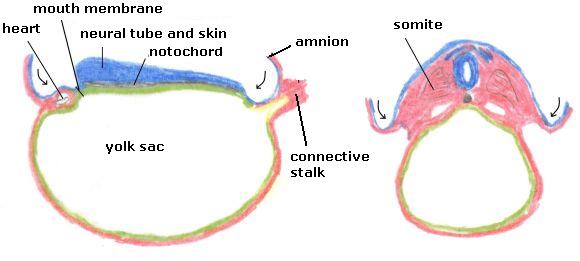
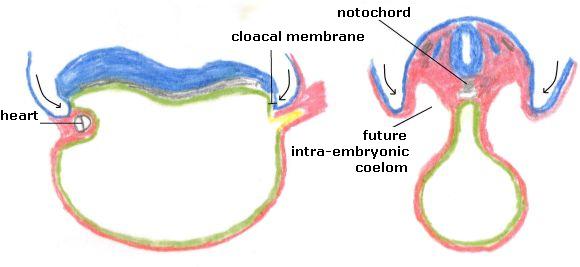
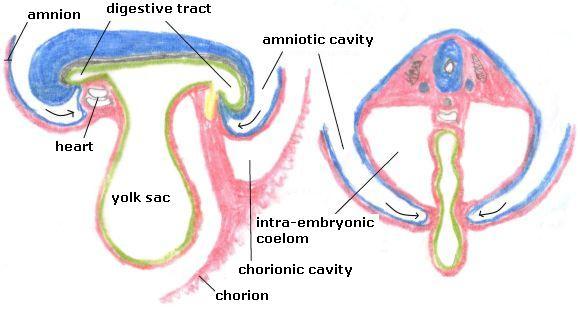

Fig. 32 shows two side views of the embryo in the fourth week. In the drawing from the middle of the fourth week, the 24th day (Fig. 32 left, corresponds with Fig. 29), the amnion surrounds the embryonic disc and the cylindrical embryo is created. Visible is the large hump of the heart that has been pushed from its cranial position above the head to a location in the chest. The neural tube is still open on both sides. The connective stalk and the yolk sac are visible.
At the end of the fourth week, the 28th day (Fig. 32 right, corresponds with Fig. 31), the complete enclosure of the amnion and the umbilical cord (containing blood vessels, connective stalk, yolk sac and allantois) are visible. The heart has grown and descended a bit more and now lies on its final place adjacent to the umbilical cord. The embryo has a short tail and has become rounder. The head and tail are bent to the inside. The head is large; the headside develops faster then the tailside. At the head folds have appeared, caused by the fast thickening of the tissue of the neural tube that thereby bends the head downward. The first arch is the mandibulary arch, from which the upper jaw grows. The last two folds are called branchial (gill) arches, similar to the folds in fish. The beginning of an eye and an ear are visible. The limbs grow, the first beginnings of an arm and a leg can be seen (see the next page for the development of the limbs).
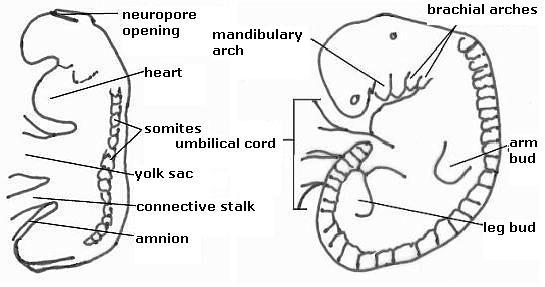
Figure 32. Left: an embryo on day 24, right on 28 days, respectively. 2 and 5 mm long.
Neural tube and digestive tract
The neural tube arises from the centre, the digestive tract from the extremities. In the neural tube there is clear amniotic fluid, which exerts pressure on the wall. In the digestive tract is turbid yolk liquid, which does not. The neural tube is mainly a straight tube, the digestive tract is a tube that winds in and out (the intestines). The neural tube consists of ectoderm, the digestive tract of entoderm. Ectoderm comes from the back, which may be called the antipathy-side of the body (to turn your back on someone). Entoderm comes from the front side, the sympathy-side of our body. With ectoderm we demarcate ourselves and create distance (observing), with entoderm we create connections (digestion of food).
| neural tube | digestive tract | |
| arises from | the middle | the extremities |
| fluid | clear amniotic fluid, exerts pressure | trouble yolk fluid, no pressure |
| tissue | ectoderm | entoderm |
| form | straight | winding |
| where | backside = antipathy-side | frontside = sympathy-side |
Table 4. Differences between the neural tube and the digestive tract
Characteristics
The processes of the third week gave the embryo volume, but did not give the embryonic disc a boundary. At the beginning of the fourth week, the embryonic disc extends into the enclosing tissues of amnion, chorion and yolk sac. The enclosing movement of the amnion separates the embryo from the enclosing tissues and emancipates the embryonic disc. It still takes a long time before the embryo is independent, but the beginning is there, now that the body gets its first form and is connected to the nourishing tissues by the umbilical cord. Steiner called this stage "Paradise Man", by which he meant to say that this is the first separation of man from his environment.
Now the body is apart and three-dimensional. The body bends and is directed towards a centre (Fig. 32). Hartmann uses the name "Animal Man".
The enveloping movement of the amnion has as a result, that the back-side is now on the outside and what was on the ventral side now lies within. It is an enveloping gesture.
The umbilical cord is on the ventral side of the embryo. It started as the connective stalk at the backside, then it moved to the tail and now it shifts to the abdomen. The nourishment came from behind in the stage of the "Plant Man"; from the front in the stage of the "Animal Man".
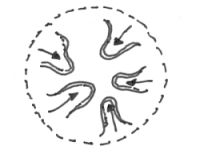
Figure 33. Animal Man (from Van der Wal, by Hartmann)
Indicated is that an animal is an organism with content or volume. It is focused inwardly on a centre.
The three tissues of the embryonic disc and what arises from them
The embryonic disc consists of three germ layers:
- Ectoderm
- Entoderm
- Mesoderm
From the ectoderm arise:
- The skin
- The nervous system
- The senses
From the entoderm arise:
- The digestive tract and digestive organs (liver, pancreas)
- The lungs
- The bladder (from the allantois)
The mesoderm can create three types of tissues:
- It can concentrate and grow inward to form muscles, tendons, ligaments and bones;
- And the kidneys, spleen and reproductive organs.
- It can go to the periphery to form body cavities, such as the pericardium, the lung cavity, the abdominal cavity, etc.
- It can do both at once and form blood cells, blood vessels and the heart.
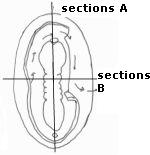
Figure 28. Dorsal view (above) and longitudinal- (A) and cross-section (B) through an embryo of 22 days
The amnion grows and bulges cranially and caudally in length and laterally at the sides around the embryo. In this movemant the heart will be pushed to its place in the chest. The embryo is still more or less flat.
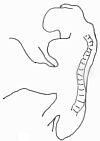
Figure 29. Side view (above) and longitudinal- and cross-section through an embryo of 24 days
The enclosure of the embryo by the amnion is further than in Fig. 28. The heart no longer lies cranial of the mouth membrane, but more inwardly. The embryo is slightly curved. The mouth and cloacal membrane are places where no mesoderm is formed between ecto- and entoderm.

Figure 30. Side view (above) and longitudinal- and cross-section of an embryo of 26 days
The heart is pushed further inward and is more or less in its final position. Because the amnion wraps around the embryo, the entoderm is folded to the centre and creates a tube, the digestive tract. See the following figure, too. The cross-section shows that a part of the chorionic cavity now lies in the body as the intra-embryonic coelom.

Figure 31. Side view (above) and longitudinal- and cross-section of an embryo of 28 days
The embryo is almost entirely enveloped in the amnion. The digestive tract is created. The umbilical cord is visible. In it are the connective stalk, the yolk sac and the allantois. The embryo lies in the amniotic cavity, which is in the chorionic cavity.
